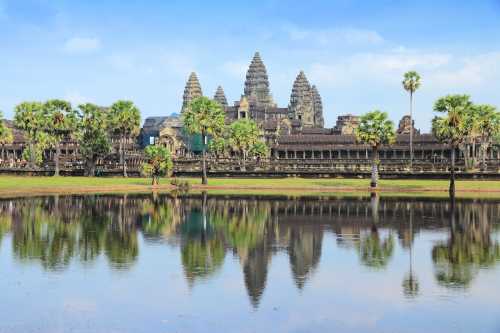Popular Trip Moments
[Ta Prohm, Siem Reap, Cambodia "Trees embracing stones, ruins that swallow up time. Beauty returning to nature"] | [Angkor Thom | Siem Reap, Cambodia "An ancient city gazed upon by stone faces. The overwhelming scale of the royal city"] | AmanSara | A Tranquil Luxury Retreat at the Angkor Archaeological Park Hotel: AmanSara Resort Address: Phum Boeung | Preah Palilay: Forgotten Buddhist Jewel | Witness the World Wake Up — Angkor Wat’s Magical Mirror Sunrise 🌅🛕 | Exploring the Sacred Paths: Buddhist Pilgrimage Routes of Angkor Wat and Angkor Thom | Best Sites to Witness Sunset in Angkor Archaeological Area | 📸 Best Photo Spot at Bayon Temple – The Front Lawn View! | Hiking Phnom Bakheng: Views of Timeless Jewel of Angkor | The Ancient Liquid Mirrors: Water Pools of Angkor | Whispers of the Jungle: The Magic of Ta Prohm Temple | Whispers of History at Bayon Temple, Angkor Thom | Sunrise Magic at Cambodia’s Ancient Wonder | Khmer Home Resort, Experience Tranquility and Comfort | 🗡️ Preah Khan: The Temple of Swords & Secrets | “Caught between sunrise and the 12th century ✨🛕” | After Being Scammed 3 Times in Cambodia, I Compiled This "Anti-Scam Guide" | 🕉️ Uncover Angkor Wat’s Hidden Secret: The Hall of a Thousand Gods 🛕 | Angkor Wat – Sunrise Magic & Ancient Wonder 🌅🏰 | 🌾🏡 A "green village" resort on the outskirts of Cambodia where tranquility and culture live. 📍Zannier Phum Baitan | Angkor Regent | A Must-Stay Value-for-Money Choice in Angkor | Majestic Angkor Wat | 🌿✨ *Srah Srang Tbong Village: Cambodia’s Hidden Silk-Weaving Sanctuary* 🧵🐛 | 🔥 "Echoes of Conflict: A Solo Journey Through Siem Reap’s War Museum" 💣 | 🌿 Hidden Gem Alert: Solo Trip to Banteay Kdei! 🏛️** | 🌅 Sunset Majesty: Solo Trip to Phnom Bakheng! 🏛️ | 🌿 The Enchanted Ruins: Solo Trip to Preah Khan Temple! 🏛️ | 🌿 The Smiling Stones: Solo Trip to Bayon Temple, Angkor Thom! 🗿 | 🌿 Ancient Wonders & Solo Adventures: Angkor Wat, Cambodia! 🏛️ | The Sacred Summit: Ascending to Angkor Wat's Second Floor Sanctuary
Recommended Attractions at Popular Destinations
Popular Attractions in Bangkok | Popular Attractions in Manila | Popular Attractions in Tokyo | Popular Attractions in Taipei | Popular Attractions in Hong Kong | Popular Attractions in Seoul | Popular Attractions in Kuala Lumpur | Popular Attractions in Los Angeles | Popular Attractions in Shanghai | Popular Attractions in New York | Popular Attractions in Shenzhen | Popular Attractions in Osaka | Popular Attractions in Singapore | Popular Attractions in London | Popular Attractions in Guangzhou | Popular Attractions in San Francisco | Popular Attractions in Beijing | Popular Attractions in Macau | Popular Attractions in Bali | Popular Attractions in Jakarta | Popular Attractions in Paris | Popular Attractions in Ho Chi Minh City | Popular Attractions in Istanbul | Popular Attractions in Phuket | Popular Attractions in Chicago | Popular Attractions in Seattle | Popular Attractions in Toronto | Popular Attractions in Orlando | Popular Attractions in Cebu | Popular Attractions in Chiang Mai
Popular Restaurants in Siem Reap
Chanrey Tree Restaurant | Khmer Kitchen | Haven | The Glasshouse Deli. Patisserie | Malis Restaurant Siem Reap | The Sugar Palm | Amok Restaurant | My Little Cafe | Khmer Family Restaurant - Pub Street | Por Cuisine | Arun Restaurant | Tang Kitchen | Curry Walla | Gelato and Coffee Lab | Khmer Touch Cuisine | Paper Tiger Eatery | Cuisine Wat Damnak - Siem Reap | Old House Restaurant | Temple Coffee n Bakery | Slek Morn Restaurant | Common Grounds Cafe | Hard Rock Cafe | Kroya | Fresh Fruit Factory | Banlle restaurant | Angkor Snow Ice | Cambodian BBQ Restaurant | Traditional Khmer Food Restaurant | Celadon Restaurant | The Little Red Fox Espresso Cafe
Popular Ranked Lists
Top 10 Luxury Hotels near Windsor County | Top 50 Must-Visit Restaurants in Bangkok | Top 20 Luxury Hotels near Radovljica | Top 10 Luxury Hotels near Trou d' Eau Douce | Top 10 Luxury Hotels near Otocec | Popular Luxury Hotels Near Kauai County | Top 50 Must-Visit Restaurants in Sapporo | Top 50 Must-Visit Restaurants in Munich | Top 50 Must-Visit Restaurants in Osaka | Top 50 Must-Visit Restaurants in Frankfurt | Popular Trending Attractions in Quanzhou | Top 50 Must-Visit Restaurants in Changsha | Top 10 Luxury Hotels near Ujjain | Top 10 Luxury Hotels near Opcina Pucisca | Top 50 Must-Visit Restaurants in Langkawi | Top 50 Must-Visit Restaurants in Guangzhou | Popular Trending Attractions in Guiyang | Top 10 Trending Attractions in Osaka | Popular Trending Attractions in Paris | Top 10 Trending Attractions in Phuket | Popular Trending Attractions in Kunming | Top 10 Trending Attractions in Kyoto | Top 10 Trending Attractions in Hong Kong | Top 50 Must-Visit Restaurants in Madrid | Top 10 Trending Attractions in Guangzhou | Top 10 Luxury Hotels near Sorrento | Top 10 Luxury Hotels near Makarska | Top 10 Luxury Hotels near Springwood | Top 50 Must-Visit Restaurants in Kuala Lumpur | Top 10 Must-Visit Restaurants in Bad Ischl
About
Payment Methods
Our Partners
Copyright © 2025 Trip.com Travel Singapore Pte. Ltd. All rights reserved
Site Operator: Trip.com Travel Singapore Pte. Ltd.
Site Operator: Trip.com Travel Singapore Pte. Ltd.














